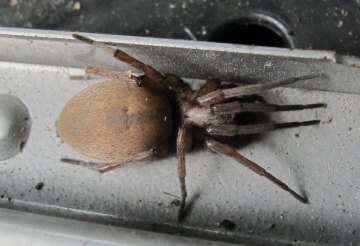Summary for Drassodes lapidosus (Araneae)
previous species | next species
National Distribution
Terms of Use. Double-click on map to go to region

Explore Regional Distribution
Identification guidance for Drassodes lapidosus
Please log on and add a note on this species
About this species
Recorded altitude range0m to 518m
Species text
DistributionThe species is widespread in the southern half of Britain, but its distribution becomes patchy and very scattered in the north. It is widespread in western and central Europe as far north as southern Norway, but not included in the checklists for the Netherlands and Sweden.
Habitat and ecology
As the name suggests, D. lapidosus is found in stony areas such as scree and the drier parts towards the rear of shingle beaches. It is also synanthropic, associated with man-influenced habitats such as gardens and waste ground where piles of old masonry, discarded clothes, etc. have been dumped. Specimens are usually found in silken cells under stones. The peak period for mature specimens appears to be from summer to autumn, but mature specimens have also been collected all round the year. As with D. cupreus, it is not unusual to find a mature male together with a penultimate instar female in the same silken cell. Males occur between May and July, peaking in June, Females may persist until the autumn.
Status
Local, less common than D. cupreus in parts of the south of England, and scarcer in the north. D. lapidosus has often been confused with D. cupreus. In appearance D. lapidosus often has a silky grey coat and mouse-like appearance, whilst D. cupreus often has a distinctly copper coloured coat (as indicated by its name). Both species occur on the Continent where a number of very closely related species are also found. For a long time, it seems that taxonomists used D. lapidosus as a 'blanket species' and it is probable that a number of different Drassodes species lie buried among the numerous Continental records of D. lapidosus.
Original author of profile: J.A. Murphy
Text based on Harvey, P.R., Nellist, D.R. & Telfer, M.G. (eds) 2002. Provisional atlas of British spiders (Arachnida, Araneae), Volumes 1 & 2. Huntingdon: Biological Records Centre. References
Adult Season
Habitats
background methodology
Recorded management for locations with Drassodes lapidosus
Recorded substrate and hydrology for locations with Drassodes lapidosus
Images
please log on and upload a new image for this speciesSee also A-Z Species Index - A-Z Picture Index - previous species | next species


